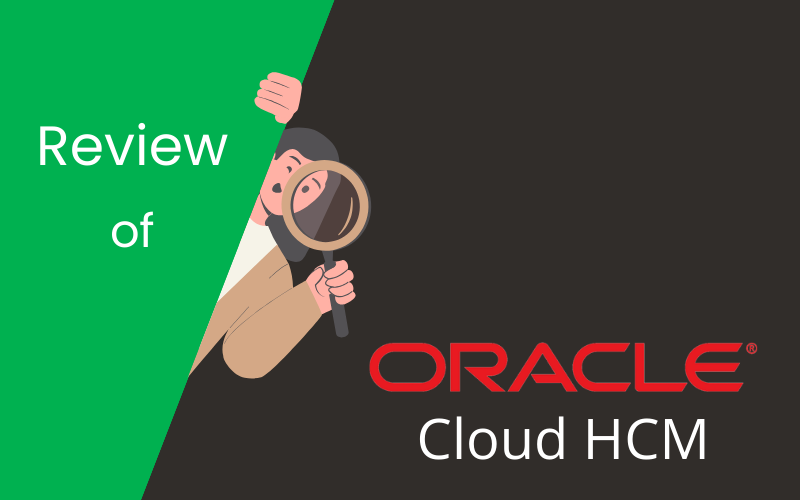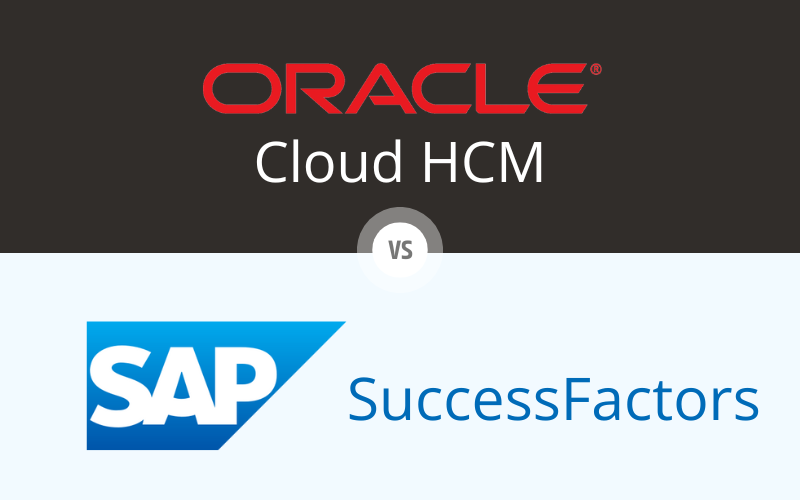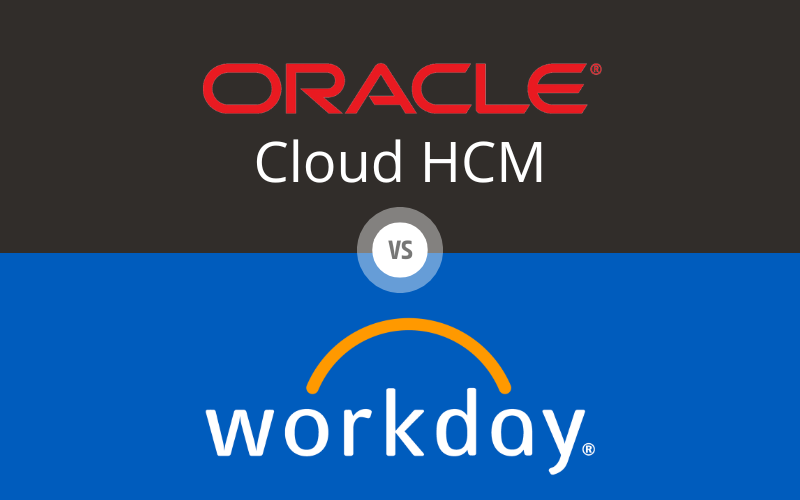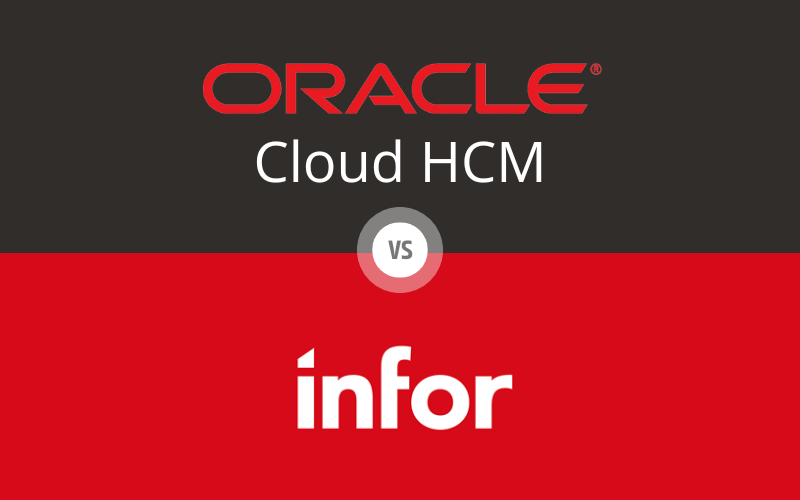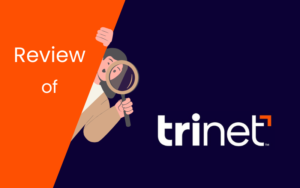This Oracle Cloud HCM review focuses on dissecting a Human Capital Management (HCM) system designed to streamline complex HR tasks. For businesses aiming to optimize their human resources capabilities, understanding the advantages and potential limitations of Oracle Cloud HCM is vital. Our review delves deeply into its features, evaluates the user experience, and contrasts it with competing solutions, all to guide you toward a well-informed choice.
Table of Contents
User Interface and User Experience
Oracle Cloud HCM’s interface and user experience are central to its functionality and impact on organizational HR processes. This review critically assesses how the UI/UX measures up in a field where user engagement and efficiency are paramount.
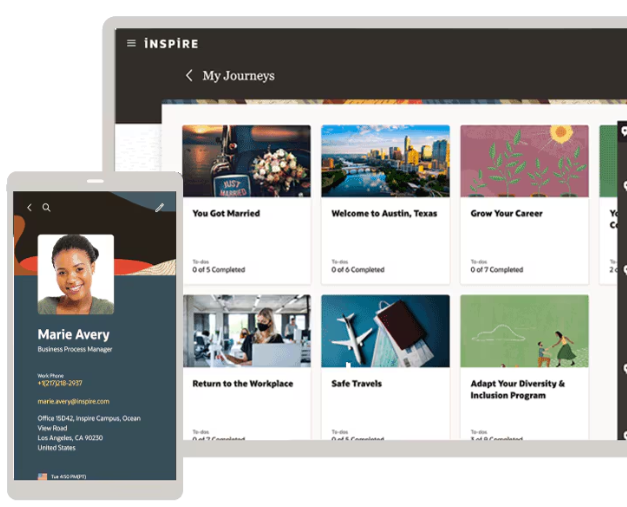
Intuitive and Clean Design
Oracle Cloud HCM offers a streamlined interface that aims to simplify user interaction and minimize training requirements. The design is modern and uncluttered, which aids in navigation but sometimes at the expense of hiding deeper features that can be challenging to access for less experienced users. While the initial usability is high, frequent users may find this design choice limits quick access to advanced tools.
Customization and Personalization
The platform allows significant customization of dashboards and reports, which is advantageous for tailoring the system to specific organizational needs. However, the depth of customization available can also pose a challenge; the options can be overwhelming, and making full use of these capabilities often requires a deeper understanding of the system or additional training.
Mobile Responsiveness
The mobile version of Oracle Cloud HCM is robust, reflecting the desktop functionality effectively and allowing for a flexible HR management experience across devices. This is particularly useful for remote or field employees. However, some users report occasional sluggishness and a less intuitive user interface on mobile devices, which can hinder the on-the-go experience.
Accessibility and Support
Oracle Cloud HCM is designed with accessibility in mind, featuring support for keyboard navigation and screen reader compatibility, which makes the platform usable for a diverse workforce. On the support side, while Oracle offers comprehensive resources, users have expressed that finding the right kind of support can sometimes be cumbersome, and responses may not always be swift or as helpful as expected.
Engaging User Interaction
Interactive elements such as drag-and-drop functionality and real-time updates are integrated into the system, aiming to enhance the user experience. These features generally improve the efficiency of routine tasks and data management. However, some users find that the interface can be cluttered when too many interactive elements are in use, which occasionally leads to a confusing user experience.
Conclusion
Oracle Cloud HCM’s UI and UX are designed to accommodate a range of business environments, aiming to streamline and enhance the HR management experience. The platform excels in customization and modern design but may present a steep learning curve for new users and those not tech-savvy. The balance between comprehensive functionality and user-friendly design does not always meet every user’s needs, which is a critical consideration for organizations aiming for rapid adoption and minimal training.
Pros of Oracle Cloud HCM’s User Interface and User Experience:
- Intuitive Design: Facilitates ease of use and quick adoption.
- Customization: Extensive options enhance relevance to user-specific needs.
- Mobile Responsiveness: Supports effective HR management across devices.
Cons of Oracle Cloud HCM’s User Interface and User Experience:
- Complex Customization Options: Can be overwhelming without sufficient training.
- Navigation Challenges: Advanced features can be difficult to access.
- Inconsistent Mobile Experience: Occasional sluggishness may affect productivity.
This review provides a balanced examination of Oracle Cloud HCM’s user interface and user experience, highlighting both its strengths and areas where improvements could enhance user satisfaction and operational efficiency.
Core HR Functions
In this section of our Oracle Cloud HCM review, we delve into the core HR functions of the platform. These are essential for managing the fundamental human resources tasks within any organization. Oracle Cloud HCM is designed to handle these tasks efficiently, but how does it truly perform when put to the test in diverse operational environments?
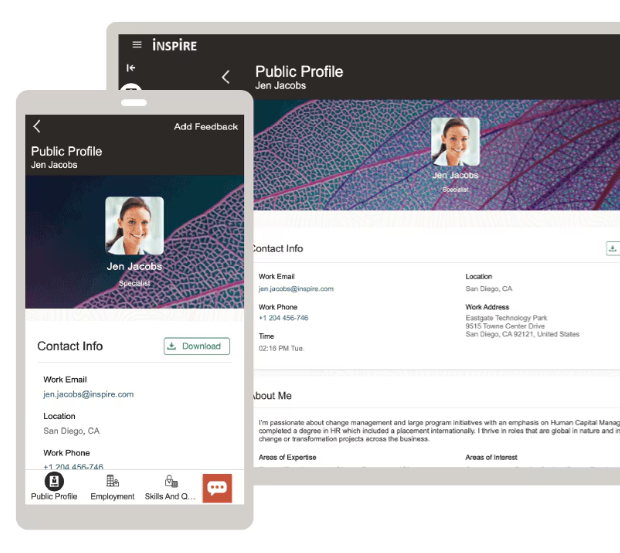
Comprehensive Employee Record Management
Oracle Cloud HCM excels in providing a centralized system for all employee records. The platform allows for the storage and management of extensive data, including personal information, job history, benefits, and compliance documents. This is a crucial function as it ensures that all employee data is secure and accessible, providing HR professionals with the tools they need for effective workforce management. However, users have noted that while comprehensive, the system can sometimes be cumbersome to navigate, especially when trying to retrieve specific data quickly.
Streamlined Onboarding and Offboarding
The onboarding process in Oracle Cloud HCM is robust, featuring automated workflows that guide new hires through every step of their introduction to the company. From digital document signing to structured training modules, the system is designed to make new employees feel welcome and to get them up to speed efficiently. Similarly, the offboarding process is handled with care, ensuring that transitions are smooth and compliant with organizational policies. Yet, the depth of customization available can make setting up these processes somewhat complex, requiring significant upfront investment in system setup.
Time and Attendance Management
Oracle Cloud HCM provides powerful tools for managing time and attendance. The system integrates time tracking with payroll and other HR functions, reducing errors and streamlining operations. Real-time attendance data helps managers make informed decisions about labor needs and compliance. Despite its capabilities, some users find the interface for time tracking less intuitive, which can lead to challenges in adoption among employees not accustomed to digital HR systems.
Robust Benefits Administration
Benefits management within Oracle Cloud HCM is a standout feature, offering flexible options for configuring and managing a wide array of employee benefits. The platform supports automatic updates to keep pace with changing regulations and offers employees a portal for self-service, enhancing transparency and satisfaction. However, the complexity of the benefits module may require additional training for HR staff to fully leverage the system’s capabilities.
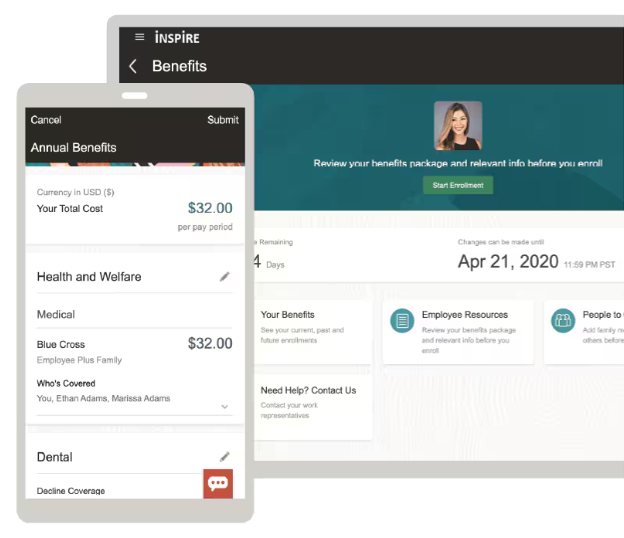
Effective Compliance Tools
Staying compliant with local and international HR regulations is straightforward with Oracle Cloud HCM, thanks to its built-in compliance features. The system is updated regularly to reflect the latest legal requirements, providing peace of mind for organizations across geographies. While comprehensive, the challenge remains in customizing these tools to specific organizational needs, which can be a daunting task given the breadth of options available.
Conclusion
The core HR functions of Oracle Cloud HCM are designed to streamline and optimize human resources management across organizations. The platform’s strengths lie in its comprehensive data management, automated HR workflows, and robust compliance features. However, the complexity inherent in its extensive customization options and some user interface aspects may pose challenges for less technically adept users or smaller organizations without dedicated IT support.
Pros of Oracle Cloud HCM’s Core HR Functions:
- Comprehensive Data Management: Centralizes all employee data, enhancing security and accessibility.
- Automated HR Processes: Streamlines onboarding and offboarding, saving time and reducing errors.
- Integrated Time Tracking: Links directly with payroll, enhancing accuracy and compliance.
Cons of Oracle Cloud HCM’s Core HR Functions:
- System Complexity: Can be cumbersome to navigate and customize without adequate training.
- User Interface Issues: Some modules may not be as user-friendly, potentially slowing down user adoption.
- Training Requirements: Requires significant investment in user training to fully exploit the system’s capabilities.
This balanced review provides insights into the core HR functions of Oracle Cloud HCM, helping organizations understand where the platform excels and where it may require additional effort to meet their specific needs.
Payroll Management
In this segment of our Oracle Cloud HCM review, we assess the platform’s capabilities in managing one of the most critical functions for any business: payroll management. Oracle Cloud HCM promises to streamline payroll processes with its integrated systems, but let’s examine how it performs under scrutiny.
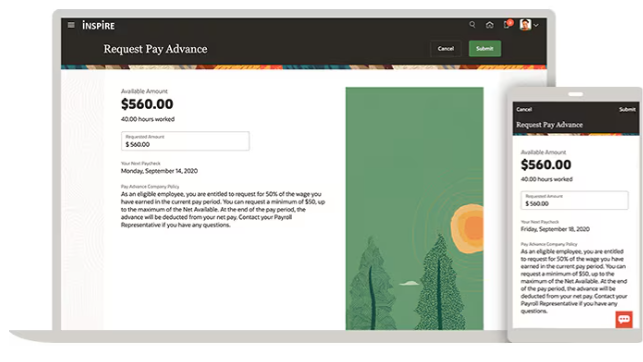
Integrated Payroll System
Oracle Cloud HCM offers an integrated payroll system that is designed to reduce the administrative burden associated with payroll processing. This system is capable of handling complex payroll requirements, including multiple pay cycles, various employee types, and compliance with tax laws across different regions. The integration with other core HR functions means that data flows seamlessly, reducing errors and ensuring that employees are paid correctly and on time. However, users have noted that setting up and customizing the payroll system can be intricate and time-consuming, requiring significant upfront configuration.
Automation and Accuracy
A key feature of Oracle Cloud HCM’s payroll management is its high level of automation. The platform can automate calculations for wages, deductions, and taxes, which not only saves time but also minimizes the risk of human error. Additionally, Oracle Cloud HCM provides real-time validation of payroll data, which helps to catch and correct errors before the payroll run. While automation is a strength, some users find the system’s numerous options and settings overwhelming, particularly those new to sophisticated payroll software.
Compliance and Reporting
Oracle Cloud HCM excels in maintaining compliance with tax regulations and reporting requirements. The system is regularly updated to reflect the latest legal changes, a crucial feature for companies operating in multiple jurisdictions. Oracle also offers detailed payroll reports and analytics, which can aid in strategic decision-making and help ensure compliance with all applicable laws. Despite these strengths, generating custom reports can be complex and may require technical knowledge to navigate the advanced settings.
Employee Self-Service Portal
The employee self-service portal within Oracle Cloud HCM is a significant benefit, allowing employees to access their pay slips, tax forms, and payroll history at any time. This transparency improves employee satisfaction and reduces the workload on HR departments by decreasing the number of inquiries and requests related to payroll. However, some users have reported that the interface of the self-service portal is not as intuitive as it could be, potentially affecting the overall user experience.
Conclusion
Oracle Cloud HCM’s payroll management features are robust, offering comprehensive tools that automate and simplify the payroll process. The integration with other HR functions and compliance updates are particular strengths that make this platform appealing to large organizations with complex payroll needs. Nevertheless, the complexity of the system and the user interface challenges highlight a potential area for improvement, especially to enhance usability for all user levels.
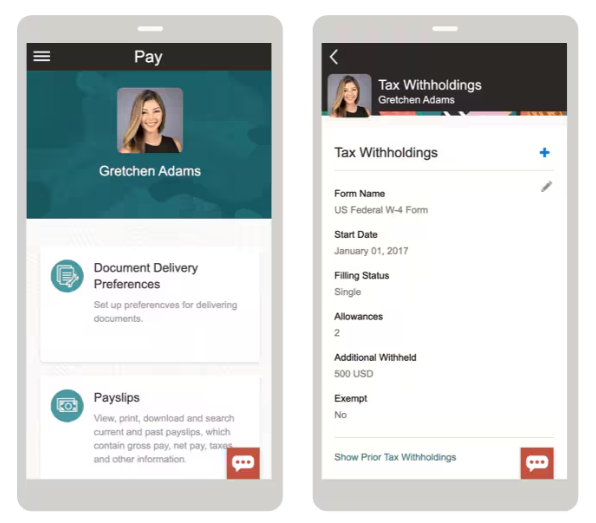
Pros of Oracle Cloud HCM’s Payroll Management:
- Integrated System: Streamlines payroll processes with other HR activities, enhancing efficiency.
- High Automation: Reduces manual tasks and the potential for errors in payroll calculations.
- Compliance and Reporting: Keeps up-to-date with tax laws and provides robust reporting capabilities.
Cons of Oracle Cloud HCM’s Payroll Management:
- Complex Setup: Requires considerable time and effort to configure and customize.
- Overwhelming Options: Can be daunting for users without extensive payroll or technical experience.
- User Interface Challenges: Some aspects of the self-service portal could be more user-friendly.
This detailed review of Oracle Cloud HCM’s payroll management capabilities provides a clear view of what organizations can expect when adopting this system. It highlights the sophisticated tools available while also acknowledging the need for potential users to prepare for a steep learning curve and significant setup investment.
Time and Attendance Tracking
In our Oracle Cloud HCM review, we explore the platform’s capabilities in managing time and attendance, a fundamental aspect of HR that affects everything from payroll to compliance. Let’s delve into how Oracle Cloud HCM handles these crucial functions.
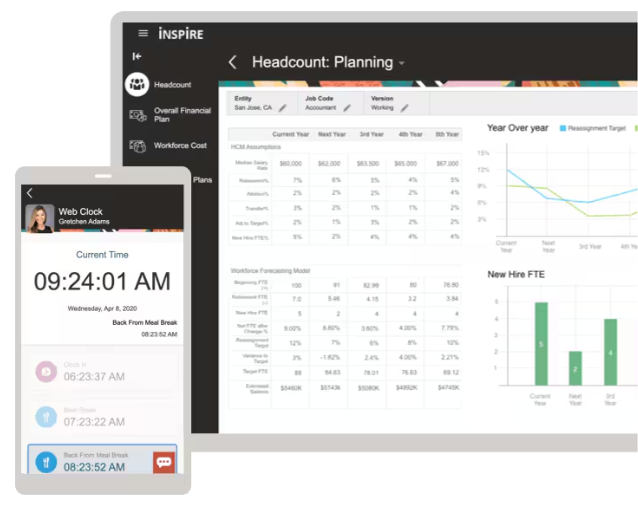
Accurate Time Recording
Oracle Cloud HCM provides sophisticated tools for recording employee work hours. The system supports various methods of time tracking, including web clock-ins, mobile time entries, and integrations with physical time clocks. This flexibility ensures that organizations can choose the method that best fits their operational needs. However, some users have reported that while the system is highly accurate, the multitude of options can sometimes complicate the initial setup and employee training.
Seamless Integration with Payroll
A standout feature of Oracle Cloud HCM is its seamless integration of time and attendance data with payroll systems. This integration ensures that hours worked are accurately reflected in payroll calculations, reducing the risk of errors and ensuring timely and correct employee payments. The system’s capability to handle complex scenarios like overtime, shift differentials, and holiday pay is particularly valuable for organizations with diverse workforce arrangements. Despite these benefits, navigating through integration settings can be challenging for new users or those not familiar with Oracle’s interface.
Real-Time Attendance Management
Oracle Cloud HCM allows managers to monitor attendance in real time, providing them with up-to-the-minute data on employee attendance patterns. This capability is crucial for managing staffing levels and ensuring operational efficiency. The platform also includes features for scheduling, which help in planning and optimizing workforce deployment. While these tools are powerful, the complexity of the system can sometimes make it difficult to extract specific attendance reports without custom configurations.
Compliance with Labor Laws
Maintaining compliance with labor laws is essential for any business, and Oracle Cloud HCM supports this by automatically updating its systems to reflect changes in regulations. The platform can also be configured to alert managers about potential compliance issues, such as breach of work hours or insufficient breaks, helping to mitigate risks before they become significant issues. However, setting up compliance alerts and rules requires a thorough understanding of both the software and the relevant labor laws, which may require additional training for HR staff.
Employee Self-Service Capabilities
Oracle Cloud HCM empowers employees through a self-service portal where they can view their time cards, submit time-off requests, and manage their schedules. This level of transparency and control improves employee satisfaction and reduces the administrative burden on HR departments. Despite its advantages, some employees may find the portal interface less intuitive, particularly those who are less tech-savvy.
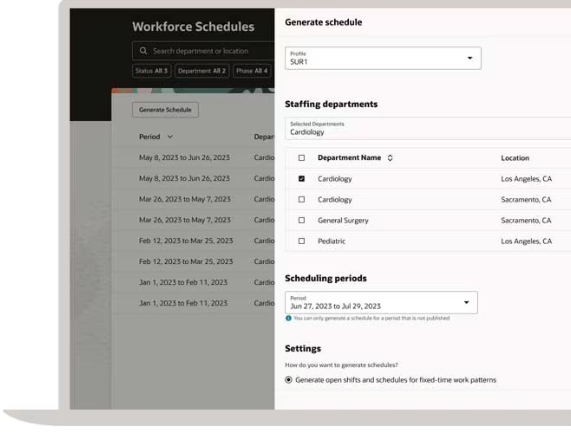
Conclusion
Oracle Cloud HCM’s time and attendance tracking capabilities are robust, offering comprehensive tools that integrate closely with other HR functions to enhance overall efficiency. The system’s real-time tracking and compliance features make it a powerful asset for any organization looking to optimize their workforce management. However, the platform’s complexity and the detailed setup it requires can be daunting for some users.
Pros of Oracle Cloud HCM’s Time and Attendance Tracking:
- Integrated Payroll Processing: Ensures accurate and timely payroll based on precise time tracking data.
- Real-Time Data: Provides managers with immediate access to attendance information.
- Compliance Features: Helps maintain adherence to various labor regulations.
Cons of Oracle Cloud HCM’s Time and Attendance Tracking:
- Complex Setup: May require significant time and expertise to configure properly.
- User Interface Challenges: Some users may find the system and self-service portal difficult to navigate.
- Training Requirements: Adequate training is essential to fully leverage the system’s capabilities.
This analysis offers a balanced look at Oracle Cloud HCM’s time and attendance tracking, highlighting its strengths in integration and compliance, while noting potential challenges related to system complexity and usability.
Benefits Administration
In this part of our Oracle Cloud HCM review, we evaluate the platform’s benefits administration capabilities, an essential aspect of HR that impacts employee satisfaction and organizational compliance. Oracle Cloud HCM’s robust system aims to simplify and enhance the management of employee benefits across diverse industries.
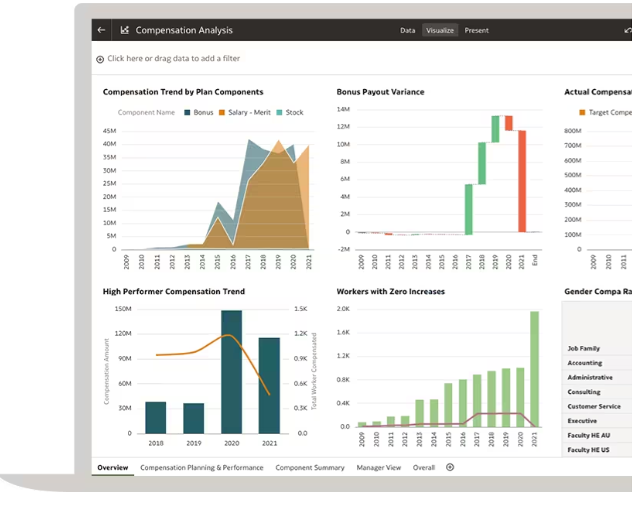
Streamlined Benefits Enrollment
Oracle Cloud HCM facilitates an efficient benefits enrollment process that helps both HR managers and employees. The system offers a guided enrollment experience, where employees can easily compare plans, view eligibility details, and make informed decisions with embedded decision support tools. While the process is designed to be user-friendly, some users report that the vast array of options can sometimes overwhelm employees without prior experience navigating such systems.
Comprehensive Benefits Management
The platform supports a wide range of benefits offerings, from traditional health insurance and retirement plans to modern perks such as wellness programs and flexible spending accounts. Oracle Cloud HCM’s flexibility in managing multiple types of benefits is a strong point, accommodating the varied needs of global workforces. However, the complexity necessary to configure and manage these diverse benefits packages can require a significant amount of setup and ongoing maintenance.
Automated Benefits Updates
One of the key strengths of Oracle Cloud HCM is its ability to automate benefits management, including updates related to life events, policy changes, and regulatory compliance. This automation ensures that benefits adjustments are handled promptly and accurately, reducing the administrative burden and minimizing the risk of errors. While automation is a valuable feature, the initial configuration and customization of these automations can be technical, potentially requiring IT support or specialized training.
Integration with Other HR Systems
Oracle Cloud HCM excels in its integration capabilities, seamlessly connecting benefits administration with other HR modules like payroll and time and attendance. This integration ensures that data flows efficiently across systems, enhancing accuracy and providing a unified view of employee information. Despite these advantages, achieving seamless integration often involves complex initial setup and fine-tuning to ensure all systems communicate effectively.
Employee Self-Service Portal
The employee self-service portal is a critical component of Oracle Cloud HCM’s benefits administration, offering employees 24/7 access to their benefits information. Employees can manage their benefits, apply for new ones, or update their information as circumstances change. The portal is designed to be intuitive, but some employees may require training to navigate it effectively, especially in organizations with a less tech-savvy workforce.
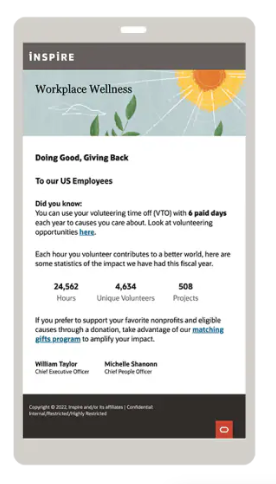
Conclusion
Oracle Cloud HCM’s benefits administration capabilities are designed to meet the needs of complex, diverse organizations seeking efficient management of a broad range of employee benefits. The system offers powerful tools for automation and integration, which can significantly streamline operations and ensure compliance. However, the platform’s complexity and the detailed knowledge required to optimize these systems are considerations that organizations need to manage actively.
Pros of Oracle Cloud HCM’s Benefits Administration:
- Streamlined Enrollment Process: Simplifies decision-making for employees with guided support.
- Comprehensive Management: Capable of handling a diverse array of benefits packages.
- Automated Updates: Keeps benefits information accurate and up-to-date automatically.
Cons of Oracle Cloud HCM’s Benefits Administration:
- Complex System Setup: Can be daunting due to the depth of options and configurations.
- Training Requirements: May necessitate additional training for HR staff and employees.
- Integration Complexity: Requires careful configuration to ensure smooth data integration across systems.
This review provides a balanced perspective on Oracle Cloud HCM’s benefits administration, emphasizing its advanced capabilities while acknowledging the challenges associated with managing such a sophisticated tool.
Performance Management
In our comprehensive Oracle Cloud HCM review, we now turn to the performance management capabilities of the system. Effective performance management is crucial for aligning employee goals with organizational objectives and fostering a culture of continuous improvement. Let’s explore how Oracle Cloud HCM supports these functions.
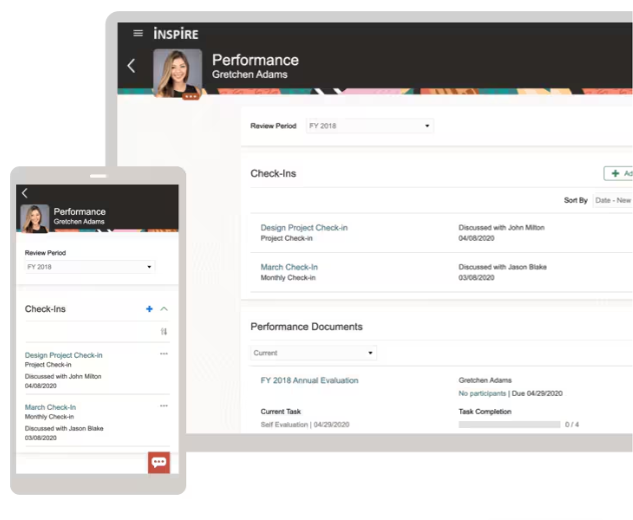
Goal Setting and Tracking
Oracle Cloud HCM facilitates robust goal-setting features that allow managers and employees to define, track, and update individual and team objectives directly within the system. The platform supports the creation of SMART (Specific, Measurable, Achievable, Relevant, Time-bound) goals, enhancing clarity and focus. While the system provides comprehensive tools for goal management, some users report that navigating these features can sometimes feel unintuitive, especially for new users who are not familiar with Oracle’s interface.
Continuous Feedback and Development
A key strength of Oracle Cloud HCM in performance management is its support for continuous feedback mechanisms. The platform enables regular check-ins between managers and employees, which can be scheduled and tracked through the system. This ongoing dialogue helps address performance issues in real-time and fosters a proactive approach to personal and professional development. However, setting up and maintaining these feedback systems requires a clear understanding of the toolset, which could be a steep learning curve for some organizations.
360-Degree Feedback
Oracle Cloud HCM supports 360-degree feedback, allowing input from multiple sources, including peers, subordinates, and supervisors, as well as self-assessments. This comprehensive feedback helps provide a well-rounded view of employee performance, which is invaluable for personal development and succession planning. While powerful, the setup and administration of 360-degree feedback within Oracle can be complex and time-consuming, potentially requiring dedicated resources to manage effectively.
Performance Analytics and Reporting
The platform offers advanced analytics and reporting capabilities that enable HR teams and managers to analyze performance data in depth. These tools help identify trends, strengths, weaknesses, and opportunities for improvement at both individual and organizational levels. Users can customize reports to fit specific requirements, although some may find the advanced reporting features to be overly complex and difficult to utilize without prior training.
Integration with Learning and Development
Oracle Cloud HCM seamlessly integrates performance management with learning and development modules. This integration allows for the alignment of performance appraisals with targeted training programs, ensuring that development efforts are directly linked to performance outcomes. The ability to tie learning directly to performance metrics is a significant advantage, though like many of Oracle’s features, it requires initial setup and ongoing management to fully leverage.
Conclusion
Oracle Cloud HCM’s performance management system is a powerful tool designed to optimize the assessment and development of employees. Its capabilities for goal setting, continuous feedback, and comprehensive analytics support an advanced performance management strategy. However, the complexity of the system may pose challenges in terms of user adoption and requires a significant commitment to training and configuration.
Pros of Oracle Cloud HCM’s Performance Management:
- Robust Goal Setting: Allows for detailed and clear objective tracking.
- Continuous Feedback: Supports a culture of ongoing development and communication.
- Comprehensive Analytics: Provides deep insights into performance trends and areas for improvement.
Cons of Oracle Cloud HCM’s Performance Management:
- System Complexity: Navigating and optimizing the full range of features can be daunting.
- Steep Learning Curve: Requires thorough training for HR personnel and end-users.
- Resource Intensive: Effective utilization may demand significant time and administrative effort.
This review offers an objective look at the performance management features of Oracle Cloud HCM, highlighting both its strengths in fostering a performance-oriented culture and the potential barriers related to system complexity and usability.
Talent Management and Recruiting
In this segment of our Oracle Cloud HCM review, we focus on the platform’s talent management and recruiting functionalities. As organizations strive to attract, develop, and retain top talent, the effectiveness of these tools is crucial. Let’s examine how Oracle Cloud HCM meets these essential needs.
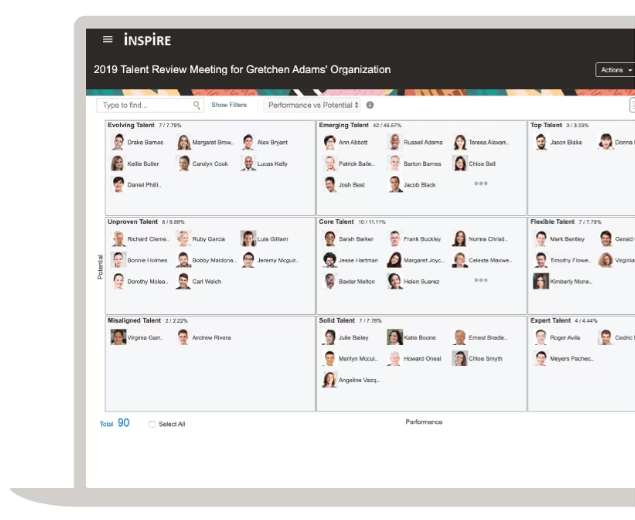
Comprehensive Recruiting Tools
Oracle Cloud HCM provides a robust set of tools designed to streamline the recruiting process. The platform includes functionalities for creating job postings, managing applications, and tracking candidates through every stage of the recruitment cycle. Integrated analytics help in identifying the best candidates by evaluating their skills and cultural fit. While the system is comprehensive, some users report that its complexity can make it difficult to utilize efficiently without substantial training.
Seamless Integration with Onboarding
A standout feature of Oracle Cloud HCM is its seamless integration from recruiting to onboarding. Once a candidate is hired, their information is automatically transitioned into the employee management system, facilitating a smooth onboarding process. This feature helps reduce administrative workload and errors associated with manual data entry. However, customizing the onboarding workflows to match specific organizational protocols can be complex and time-intensive.
Development and Succession Planning
Oracle Cloud HCM excels in supporting employee development and succession planning. The platform allows managers to identify high-potential employees and create tailored development plans that align with both individual career aspirations and organizational needs. While this promotes a proactive approach to talent development, the breadth and depth of features available can sometimes overwhelm users, particularly those new to the platform.
Performance-Linked Talent Management
The integration of performance management with talent management allows Oracle Cloud HCM to align employee performance data directly with talent development initiatives. This alignment ensures that training and development opportunities are based on quantifiable performance metrics, enhancing the precision of talent management strategies. Despite its advantages, extracting and applying this data effectively requires users to navigate a complex array of system options and settings.
Employee Self-Service and Engagement
Oracle Cloud HCM includes an employee self-service portal that empowers employees to take control of their professional development. Employees can access their performance evaluations, seek out training opportunities, and manage their career progression. This level of engagement is crucial for retaining talent, though the user interface of the portal may not always be intuitive, possibly requiring additional training for optimal use.
Conclusion
Oracle Cloud HCM’s talent management and recruiting capabilities are robust, offering tools that can significantly enhance an organization’s ability to manage its human resources effectively. From advanced recruiting to integrated development plans, the platform is equipped to handle the complexities of modern talent management. However, the system’s complexity and the need for detailed configuration and training are considerations that potential users must manage.
Pros of Oracle Cloud HCM’s Talent Management and Recruiting:
- Comprehensive Recruiting Tools: Facilitates effective candidate management from application to hire.
- Integrated Onboarding: Streamlines the transition of new hires into productive employees.
- Development and Succession Planning: Supports strategic planning for future leadership and skills development.
Cons of Oracle Cloud HCM’s Talent Management and Recruiting:
- Complex System Navigation: Can be challenging to utilize without in-depth training.
- Resource Intensive: Requires significant setup and ongoing management to fully leverage.
- User Interface Challenges: Some aspects of the system, particularly the self-service portal, may not be as user-friendly as could be hoped.
This review offers an in-depth look at Oracle Cloud HCM’s talent management and recruiting functions, highlighting the system’s strengths in fostering a skilled and engaged workforce while also noting potential barriers related to complexity and user experience.
Learning and Development
In this section of our Oracle Cloud HCM review, we evaluate the platform’s capabilities in Learning and Development (L&D). As organizations increasingly focus on continuous professional growth to maintain competitive advantage, effective L&D systems are critical. Oracle Cloud HCM aims to support organizations in fostering employee growth through its comprehensive learning management tools.
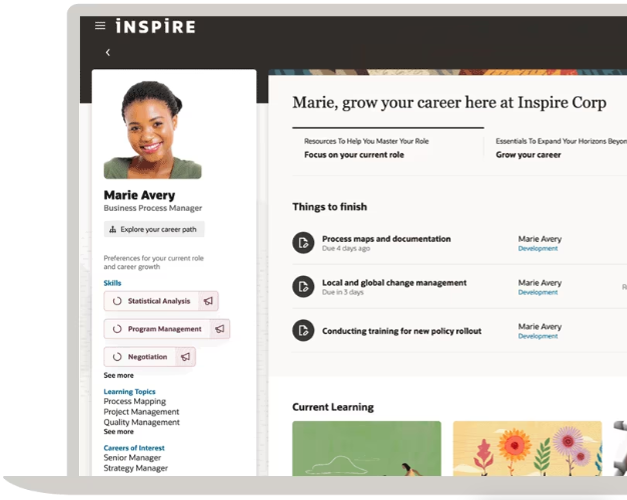
Integrated Learning Management System
Oracle Cloud HCM features an integrated Learning Management System (LMS) that is both robust and flexible. The LMS enables organizations to create, manage, and track educational programs and training sessions directly within the platform. This system supports a variety of content types, including online courses, instructor-led training, and interactive webinars. While the LMS is powerful, new users may find its extensive range of features and options somewhat overwhelming without proper training.
Personalized Learning Experiences
One of the strengths of Oracle Cloud HCM is its ability to deliver personalized learning experiences to employees. The platform uses advanced analytics to suggest courses and training programs that align with individual career paths, skills gaps, and learning preferences. This personalization helps in engaging employees more effectively and ensures that learning opportunities are relevant and timely. However, setting up these personalized learning pathways can require a detailed understanding of both the system and the specific learning needs of the workforce.
Collaboration and Social Learning
Oracle Cloud HCM promotes social learning through features that allow employees to engage with peers, share knowledge, and collaborate on learning projects. These tools include discussion forums, shared learning spaces, and peer feedback systems. The social learning aspect is designed to enhance learning retention and foster a collaborative culture. While beneficial, some organizations may need additional resources to manage and facilitate these social learning environments effectively.
Compliance and Certification Tracking
The platform also excels in managing compliance training and certification tracking. Oracle Cloud HCM allows organizations to set up mandatory training programs with automated reminders and track completion rates to ensure compliance with industry regulations and internal standards. While this feature is highly valuable for maintaining compliance, navigating and configuring the compliance settings can be complex and time-consuming.
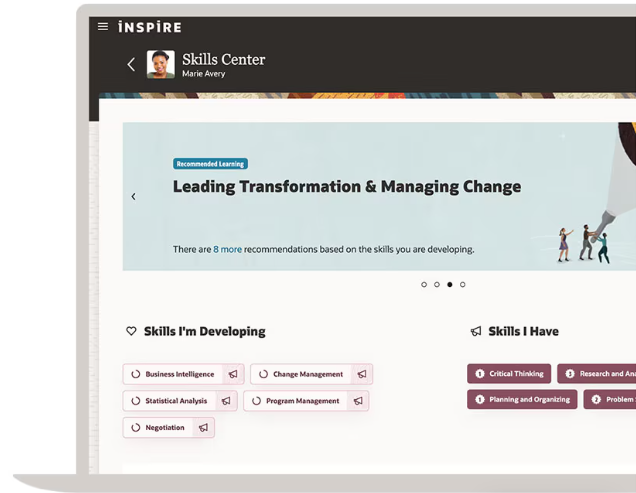
Scalability and Mobile Learning
Oracle Cloud HCM is scalable, capable of accommodating the needs of small teams to large enterprises. The platform also supports mobile learning, allowing employees to access training materials on their mobile devices at their convenience. This flexibility enhances learning accessibility but may require additional considerations for content optimization to ensure that training materials are effective on smaller screens.
Conclusion
Oracle Cloud HCM’s Learning and Development tools are designed to support a comprehensive learning strategy, with strengths in integration, personalization, and compliance. The platform offers a robust infrastructure for fostering an environment of continuous learning and professional growth. However, the complexity of its configuration and the potential need for significant training for both administrators and users are important factors to consider.
Pros of Oracle Cloud HCM’s Learning and Development:
- Integrated Learning Management: Streamlines the creation, management, and tracking of training programs.
- Personalized Learning Paths: Enhances employee engagement and development with tailored learning experiences.
- Mobile and Scalable: Supports learning anytime, anywhere, for organizations of all sizes.
Cons of Oracle Cloud HCM’s Learning and Development:
- Complex Interface: The wide array of features may be difficult to navigate without extensive training.
- Resource-Intensive Management: Requires dedicated resources to fully leverage its capabilities.
- Content Optimization for Mobile: Necessitates additional efforts to ensure training is effective across various devices.
This review provides an objective look at the learning and development features of Oracle Cloud HCM, highlighting its capability to enhance employee skills and compliance effectively, while also noting areas where usability could be improved.
Reporting and Analytics
In this portion of our Oracle Cloud HCM review, we delve into the platform’s reporting and analytics capabilities. For organizations seeking to harness data-driven insights for strategic decision-making, the effectiveness of these tools is paramount. Let’s explore how Oracle Cloud HCM equips businesses to analyze and interpret HR data comprehensively.
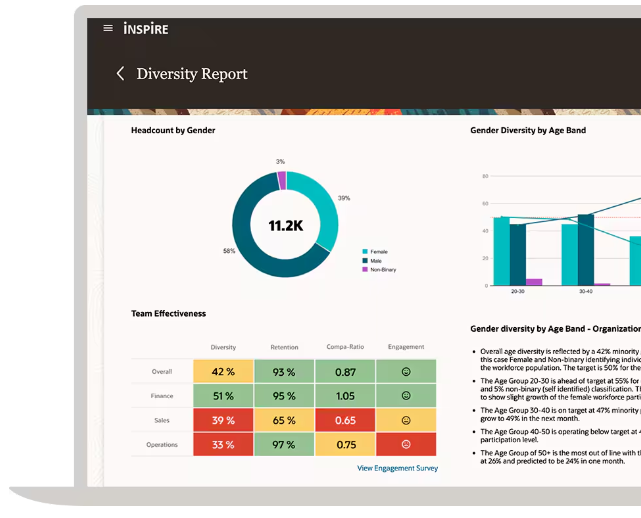
Advanced Reporting Capabilities
Oracle Cloud HCM offers a robust suite of reporting tools that enable organizations to generate detailed reports on various HR metrics, such as employee performance, turnover rates, and compensation trends. The system allows for customizable reports, where users can define specific parameters to focus on the data that matters most to their strategic goals. While these advanced capabilities provide valuable insights, they can also present a steep learning curve for users not familiar with data analytics or the Oracle reporting environment.
Real-Time Analytics
One of the significant advantages of Oracle Cloud HCM is its ability to deliver real-time analytics. This feature ensures that HR leaders and managers have access to the latest data without delays, allowing for more timely and informed decision-making. The real-time functionality is particularly useful for tracking ongoing changes within the workforce and for responding quickly to emerging trends. However, the complexity of setting up and maintaining real-time data streams can require additional technical skills.
Predictive Analytics
Oracle Cloud HCM stands out with its predictive analytics capabilities, which go beyond traditional descriptive analytics to forecast future trends based on historical data. This tool can predict potential staff shortages, employee turnover, and even suggest changes to improve employee engagement and productivity. While predictive analytics can be a game-changer for strategic planning, effectively utilizing these tools requires a deep understanding of both the software and the underlying statistical methods.
Integration with Other HR Functions
The analytics and reporting functions in Oracle Cloud HCM are fully integrated with other HR modules, such as payroll, benefits, and talent management. This integration provides a holistic view of all HR-related data, making it easier to perform cross-functional analysis and gain comprehensive insights. Despite the benefits of this integration, navigating through the interconnected data can be challenging, particularly for users without extensive experience in Oracle systems.
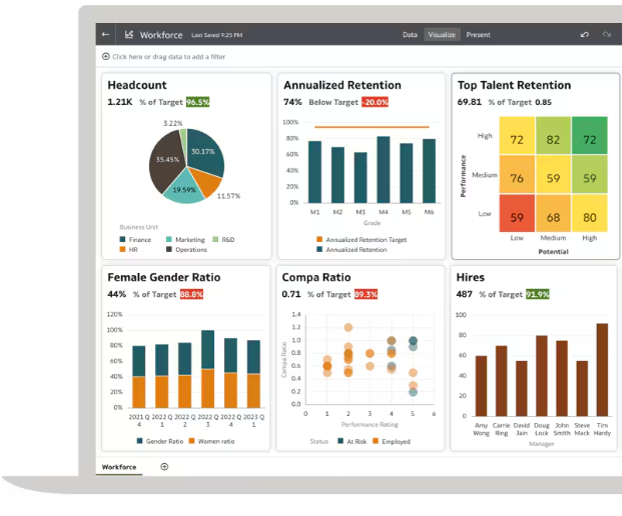
User-Friendly Dashboards
Oracle Cloud HCM includes user-friendly dashboards that provide visual representations of data, making complex information more accessible and easier to understand. These dashboards are customizable, allowing users to highlight the most crucial metrics for their specific roles and responsibilities. While the dashboards are designed to be intuitive, customizing them to meet specific user needs can require familiarity with the platform’s dashboard tools.
Conclusion
Oracle Cloud HCM’s reporting and analytics features offer powerful tools for organizations to leverage in making informed, strategic decisions. The suite of advanced reporting, real-time analytics, and predictive capabilities makes Oracle Cloud HCM a valuable asset for any data-driven HR department. However, the platform’s complexity and the technical proficiency required to fully utilize these features are important considerations for potential users.
Pros of Oracle Cloud HCM’s Reporting and Analytics:
- Comprehensive Reporting: Enables detailed analysis of a wide range of HR metrics.
- Real-Time Analytics: Offers up-to-date data for agile decision-making.
- Predictive Insights: Provides forecasts to guide future HR strategies.
Cons of Oracle Cloud HCM’s Reporting and Analytics:
- Steep Learning Curve: Complex features may be challenging for users without technical expertise.
- Resource-Intensive: Requires significant setup and ongoing management to optimize.
- Complex Navigation: Integrating and navigating extensive data sets can be daunting for less experienced users.
This review provides a detailed look at the reporting and analytics capabilities of Oracle Cloud HCM, underscoring its strength in delivering deep insights while highlighting the challenges associated with mastering its comprehensive tools.
Compliance and Security
In this segment of our Oracle Cloud HCM review, we focus on the platform’s compliance and security features. As businesses increasingly prioritize data protection and regulatory compliance, the capabilities of their HR systems in these areas become critical. Let’s assess how Oracle Cloud HCM addresses these vital needs.
Robust Data Security
Oracle Cloud HCM is built on a foundation of robust security measures designed to protect sensitive employee data. The platform employs advanced encryption techniques for data at rest and in transit, ensuring that all information is safeguarded against unauthorized access. Additionally, Oracle implements regular security audits and vulnerability assessments to maintain high security standards. While these security measures are comprehensive, they can sometimes complicate the system’s usability, particularly when deploying new updates or integrating with less secure third-party systems.
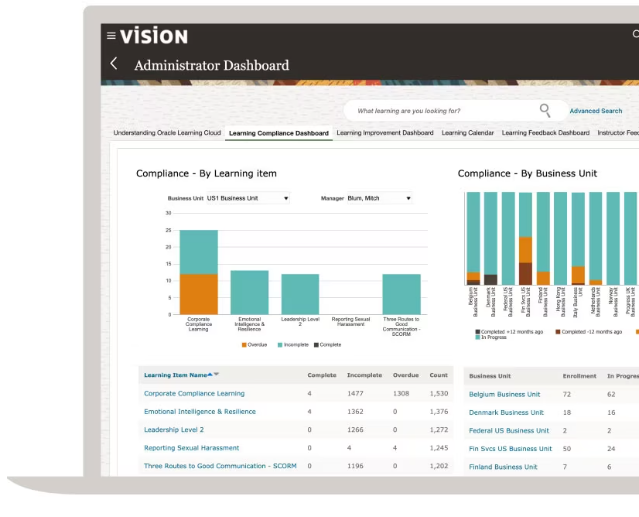
Compliance with Global Regulations
Oracle Cloud HCM excels in helping organizations comply with a wide range of global and local regulatory requirements. Whether it’s GDPR in Europe, HIPAA in the United States, or other labor laws across the globe, Oracle Cloud HCM is equipped to manage compliance efficiently. The system automatically updates to reflect the latest legal changes, which is essential for businesses operating in multiple jurisdictions. However, the complexity of configuring the system to ensure full compliance can require substantial legal and technical expertise.
Regular Compliance Updates
One of the key benefits of Oracle Cloud HCM is its capability to provide regular updates that keep the system aligned with the latest compliance requirements. These updates are critical for businesses to avoid penalties and legal issues. Oracle manages these updates centrally, which helps reduce the burden on local IT teams but also requires them to stay vigilant and proactive in applying changes and training users accordingly.
Audit Trails and Reporting
Oracle Cloud HCM supports comprehensive audit trails and detailed reporting that are essential for compliance. The platform logs all activities and changes, allowing for full traceability, which is crucial during audits. The reporting tools enable HR departments to generate compliance reports easily and effectively, supporting internal audits and regulatory reviews. While these features are powerful, navigating the reporting interface and customizing reports to meet specific audit requirements can be complex without proper training.
User Access Controls
To further enhance security and compliance, Oracle Cloud HCM includes sophisticated user access controls that allow administrators to define and enforce who can view and modify sensitive data. These controls help prevent data breaches and ensure that employees only access the information necessary for their roles. Setting up these controls is straightforward, but managing them as organizations scale and evolve can require ongoing attention and adjustments.
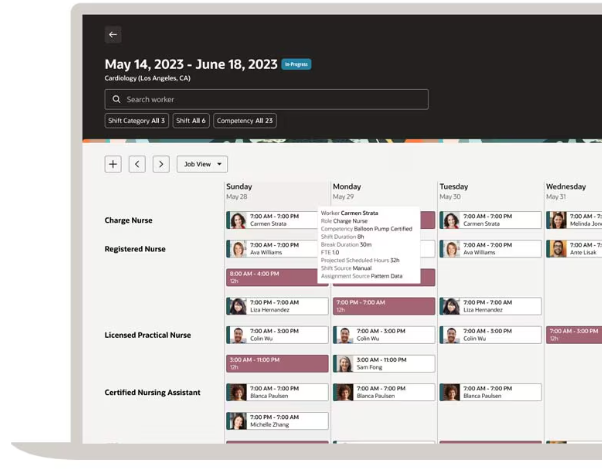
Conclusion
Oracle Cloud HCM’s compliance and security features are designed to meet the stringent requirements faced by modern organizations. The system provides robust protections and helps businesses stay compliant with ever-changing regulations. However, the sophistication of Oracle’s security and compliance functionalities means that achieving optimal setup and maintenance may involve a steep learning curve and significant resource investment.
Pros of Oracle Cloud HCM’s Compliance and Security:
- Advanced Data Protection: Utilizes top-tier security measures to safeguard sensitive data.
- Global Regulatory Compliance: Supports adherence to a wide array of international laws.
- Comprehensive Audit Trails: Offers full traceability and detailed reporting for compliance.
Cons of Oracle Cloud HCM’s Compliance and Security:
- Complex Configuration: Setting up and maintaining compliance settings can be demanding.
- Resource-Intensive Management: Requires continuous monitoring and updates.
- Training Requirements: Ensures users understand how to manage and protect data effectively.
This review provides an in-depth look at the compliance and security aspects of Oracle Cloud HCM, highlighting its ability to support businesses in maintaining high standards of data protection and regulatory compliance while noting the challenges related to complexity and resource demands.
Integration and Compatibility
In this portion of our Oracle Cloud HCM review, we focus on the system’s integration and compatibility capabilities. Effective integration with other systems and compatibility across various platforms are essential for maximizing the value of an HCM solution. Let’s examine how Oracle Cloud HCM handles these important aspects.

Extensive Integration Capabilities
Oracle Cloud HCM is designed to integrate seamlessly with a wide range of enterprise applications, including financial systems, CRM software, and other HR-related solutions. The platform uses robust APIs (Application Programming Interfaces) that facilitate smooth data exchange and process alignment across different systems. This level of integration helps organizations maintain data consistency and streamline operations. However, while Oracle offers comprehensive integration tools, the complexity of implementing these integrations can be a significant hurdle for organizations without dedicated IT resources.
Cross-Platform Compatibility
A key strength of Oracle Cloud HCM is its compatibility with various operating systems and devices, ensuring that users can access the system from virtually anywhere. Whether employees use Windows, macOS, or mobile platforms, Oracle Cloud HCM provides a consistent user experience. This compatibility is crucial for supporting a diverse and increasingly remote workforce. Despite this, some users may experience variations in performance or interface layout across different platforms, which can affect user satisfaction.
Scalability and Flexibility
Oracle Cloud HCM excels in scalability, capable of accommodating the needs of small businesses to large enterprises. The system’s architecture allows organizations to add more modules or expand to more locations as they grow. This scalability ensures that Oracle Cloud HCM can continue to meet an organization’s needs over time, adapting to changing business dynamics. Nonetheless, scaling the system often requires careful planning and additional configuration to ensure continued performance and integration efficacy.
Cloud Compatibility and Upgrades
As a cloud-based solution, Oracle Cloud HCM offers compatibility with various cloud services, providing flexibility and scalability. The platform benefits from regular updates and enhancements delivered via the cloud, which helps improve functionality and security without substantial downtime. However, keeping up with frequent updates and ensuring that all integrated systems are compatible with new versions can pose challenges for IT teams.
Third-Party Integration Support
Oracle Cloud HCM supports integration with numerous third-party applications, enhancing its functionality. This allows organizations to extend the capabilities of their HCM system with specialized tools for analytics, learning management, and more. While Oracle provides support for these integrations, the actual implementation can vary in complexity depending on the third-party software, sometimes requiring customization or additional middleware.
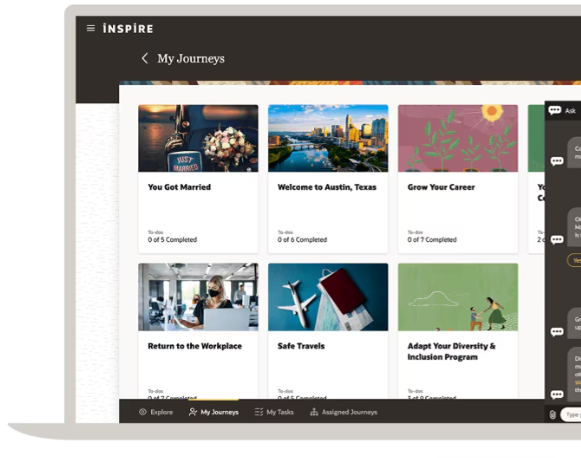
Conclusion
Oracle Cloud HCM’s integration and compatibility features are designed to provide flexibility and extensive connectivity, supporting efficient operations across diverse IT environments. The platform’s robust integration tools, cross-platform compatibility, and scalability make it a powerful solution for organizations looking to integrate their HCM with other business systems effectively. However, the technical demands of implementing and maintaining these integrations should not be underestimated.
Pros of Oracle Cloud HCM’s Integration and Compatibility:
- Extensive Integration Capabilities: Facilitates seamless data exchange across various systems.
- Cross-Platform Compatibility: Ensures access from multiple devices and operating systems.
- Scalability: Adapts to growing organizational needs without compromising performance.
Cons of Oracle Cloud HCM’s Integration and Compatibility:
- Complex Integration Processes: Can be challenging and resource-intensive to implement.
- Update Management: Requires ongoing attention to accommodate regular updates.
- Variable Third-Party Integration Ease: The ease of integrating third-party solutions can vary, sometimes requiring additional technical adjustments.
This review highlights Oracle Cloud HCM’s strengths in integration and compatibility while acknowledging potential challenges, providing organizations with a comprehensive understanding of what to expect when deploying and expanding the use of this HCM platform.
Customer Support and Service
In this part of our Oracle Cloud HCM review, we assess the platform’s customer support and service offerings. Effective support is crucial for ensuring the successful implementation and ongoing use of any HCM system. Let’s explore how Oracle Cloud HCM supports its users through customer service initiatives.
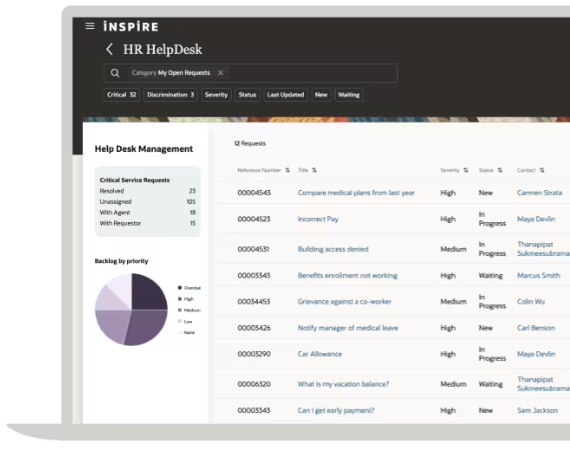
Multiple Support Channels
Oracle Cloud HCM offers a variety of support channels to cater to different user needs. Customers can access assistance through dedicated phone lines, email, and a live chat system available directly through the platform. This range of options ensures that users can choose the most convenient way to get help when they need it. However, users sometimes report varying response times, which can depend on the complexity of the issue and the channel used.
Comprehensive Online Resources
Oracle provides an extensive library of online resources, including FAQs, user guides, tutorial videos, and community forums. These resources are designed to empower users to find solutions independently, which can speed up problem resolution and reduce the need for direct contact with support staff. While these materials are generally helpful, navigating the vast amount of content available can be overwhelming for new users who are not familiar with Oracle’s organizational structure.
Training and Onboarding Support
Oracle Cloud HCM excels in offering structured training and onboarding programs that help new users understand and utilize the platform effectively. These training programs can be customized to the specific needs of an organization and are available both online and as in-person workshops. The quality of these training sessions is typically high, though some users have noted that the cost of in-depth training can be substantial.
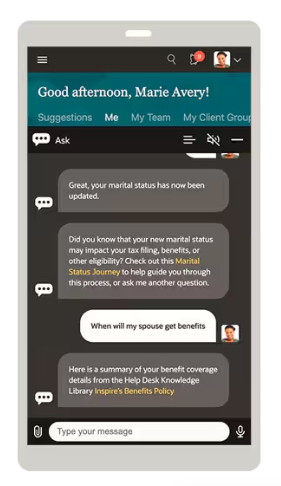
Proactive System Monitoring and Updates
One of the standout features of Oracle Cloud HCM’s support is its proactive monitoring of system performance and regular updates. Oracle not only ensures that the platform operates efficiently but also anticipates potential issues before they affect users. While this proactive approach is beneficial, the frequency and timing of updates can sometimes disrupt regular operations, especially if the changes are significant.
Global Support and Localization
Oracle Cloud HCM provides global support capabilities, with service centers located around the world to address the needs of international users in multiple languages. This global reach is crucial for multinational corporations that require support across different time zones and in various languages. Despite this extensive coverage, some international users may experience delays or face barriers due to time zone differences and localization issues.
Conclusion
Oracle Cloud HCM’s customer support and service are designed to ensure that users receive timely and effective help throughout their experience with the platform. From multiple support channels and extensive online resources to proactive system maintenance and global coverage, Oracle aims to maintain high customer satisfaction. However, potential users should be aware of the challenges related to navigation of resources, cost of personalized training, and occasional disruptions due to system updates.
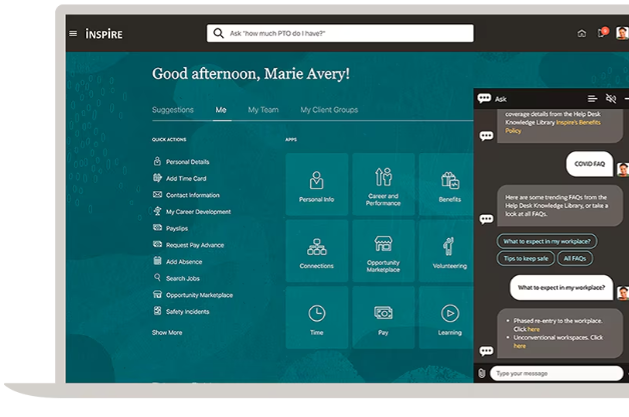
Pros of Oracle Cloud HCM’s Customer Support and Service:
- Multiple Support Channels: Offers varied options for users to seek help.
- Extensive Online Resources: Provides a wealth of information to facilitate self-service.
- Proactive Monitoring: Ensures system reliability and performance.
Cons of Oracle Cloud HCM’s Customer Support and Service:
- Inconsistent Response Times: User experiences with support can vary.
- Complex Resource Navigation: Finding specific help topics can be challenging.
- Training Costs: Comprehensive training may be expensive.
This review gives an insightful look into Oracle Cloud HCM’s customer support and service, illustrating both the strengths and areas where users might encounter challenges.
Pricing and Cost-effectiveness
In this part of our Oracle Cloud HCM review, we examine the pricing structure and overall cost-effectiveness of the platform. Understanding the cost implications is crucial for organizations considering Oracle Cloud HCM as their human capital management solution. Let’s delve into how Oracle structures its pricing and the value it delivers.

Transparent Pricing Structure
Oracle Cloud HCM is known for its transparent pricing model, which is typically based on a per-user, per-month fee. This structure allows organizations to predict their expenses more accurately and scale their usage as needed without unexpected cost increases. While transparency is a strong point, potential users should be aware that the base fees can be on the higher end of the market spectrum, reflecting the comprehensive nature of the solution.
Scalability and Flexibility
One of the key factors contributing to the cost-effectiveness of Oracle Cloud HCM is its scalability. The system is designed to grow with your organization, meaning you can start with the essentials and add more functionality as your needs evolve. This scalability can be a cost-effective strategy for businesses planning to expand or those needing to adapt to changing industry conditions. However, upgrading or adding modules involves additional costs, which can accumulate and should be planned for in the budget.
Additional Costs and Considerations
While Oracle Cloud HCM offers a clear base pricing model, there are additional costs that organizations need to consider. These can include fees for customization, integration with other systems, additional training, and premium support services. Each of these factors can significantly affect the total cost of ownership. Organizations should thoroughly evaluate these potential expenses during the planning phase to avoid budget overruns.
Return on Investment (ROI)
Evaluating the ROI of Oracle Cloud HCM involves more than just examining direct costs. The platform offers advanced features that can lead to greater operational efficiency, reduced HR administrative costs, and improved employee satisfaction and retention. These intangible benefits should be factored into the overall cost-effectiveness analysis. However, realizing these benefits to their fullest extent often requires a well-executed implementation and ongoing engagement with the platform’s capabilities.
Comparative Market Analysis
When compared to other HCM solutions in the market, Oracle Cloud HCM tends to be at a higher price point, which is justified by its extensive features, reliability, and global support structure. It is advisable for organizations to conduct a thorough comparative analysis with other HCM systems to ensure that Oracle provides the best value proposition for their specific needs.
Conclusion
Oracle Cloud HCM’s pricing and cost-effectiveness are characterized by a transparent and scalable pricing model but accompanied by potential additional costs that can impact the overall financial commitment. The system’s comprehensive features and scalability offer significant value, particularly for large enterprises or rapidly growing businesses. However, small to medium-sized organizations must carefully assess whether the benefits justify the investment.
Pros of Oracle Cloud HCM’s Pricing and Cost-effectiveness:
- Transparent Pricing: Clear per-user, per-month fees help with budget planning.
- Scalability: Adapts to organizational growth, which can be cost-effective in the long run.
- Potential for High ROI: Advanced features can lead to significant efficiency gains and cost savings.
Cons of Oracle Cloud HCM’s Pricing and Cost-effectiveness:
- Higher Base Cost: Initial and ongoing expenses can be substantial compared to some competitors.
- Additional Fees: Costs for customization, integration, and advanced support can add up.
- Complex Cost Management: Managing and optimizing costs requires careful planning and oversight.
This review provides an in-depth look at the pricing and cost-effectiveness of Oracle Cloud HCM, highlighting how its financial aspects align with its value delivery, while also pointing out the complexities involved in managing total costs.
For more information about pricing, please visit Oracle Cloud HCM’s website.
User Reviews and Testimonials
In this section of our Oracle Cloud HCM review, we explore user reviews and testimonials, which provide real-world insights into how the system performs across various organizations. Analyzing user feedback is crucial for understanding the practical strengths and potential areas for improvement of Oracle Cloud HCM. Let’s delve into what users are saying about their experiences with the platform.

Positive Feedback on Usability and Features
Oracle Cloud HCM receives widespread praise for its comprehensive range of features and overall usability. Users often highlight the platform’s robust functionality in managing complex HR tasks such as payroll, benefits administration, and talent management. Many testimonials note that once familiar with the system, the user interface facilitates a smooth workflow that can handle large-scale HR operations effectively.
Critiques on Setup and Customization
While many users are satisfied with the capabilities of Oracle Cloud HCM, some express concerns regarding the initial setup and customization process. New users often find that implementing the system can be a daunting task, requiring significant time and resources. Customization, in particular, is noted as being complex, with a steep learning curve to configure the system to meet specific organizational needs.
Customer Support Experiences
User testimonials about Oracle Cloud HCM’s customer support are mixed. Some users report positive experiences, stating that support staff are helpful and responsive, providing solutions in a timely manner. However, others have faced challenges with slower response times and varying levels of support quality, which they feel could be improved to match the premium nature of the system.
Impact on HR Efficiency
A recurring theme in user reviews is the impact of Oracle Cloud HCM on improving HR efficiency. Many organizations report that the automation and integration capabilities of the system have significantly reduced manual HR tasks and streamlined operations, leading to better resource management and cost savings. These benefits are frequently mentioned as justifying the investment in the platform.
User Interface and Navigation
Feedback on the user interface and navigation is generally positive, but some users point out areas for enhancement. While the design is clean and modern, navigating through the extensive features and finding specific functions can sometimes be challenging, especially for those who are not technically inclined.
Conclusion
User reviews and testimonials for Oracle Cloud HCM paint a picture of a powerful, feature-rich platform that excels in handling complex HR functions. The system is praised for its impact on organizational efficiency and its robust feature set. However, the challenges related to setup, customization, and occasional customer support issues are noted as areas needing attention.
Pros of Oracle Cloud HCM Based on User Reviews:
- Comprehensive Features: Users appreciate the extensive capabilities that support a wide range of HR functions.
- Improved HR Efficiency: Many testimonials highlight significant improvements in HR operational efficiency.
- Strong System Integration: The platform’s ability to integrate with other business systems is frequently praised.
Cons of Oracle Cloud HCM Based on User Reviews:
- Complex Setup and Customization: New users often find the initial setup and customization process to be cumbersome.
- Mixed Customer Support Experiences: While some users report excellent support, others encounter delays and inconsistent service.
- Navigation Challenges: Finding specific features within the extensive system can sometimes be difficult for users.
This review of user feedback for Oracle Cloud HCM provides a balanced view of the system, showcasing both its strengths and the challenges users face, helping potential customers make informed decisions based on the experiences of existing users.
Alternatives
In this section of our Oracle Cloud HCM review, we explore alternative solutions to Oracle Cloud HCM that organizations might consider. While Oracle Cloud HCM offers a comprehensive suite of HR functions, different organizations have varying needs and may find that other solutions better fit their specific requirements. Let’s examine three notable alternatives to Oracle Cloud HCM.
1. Workday
Overview: Workday is a leading provider of enterprise cloud applications for finance and human resources. It offers a unified suite that includes financial management, human capital management, planning, and analytics. Workday is known for its user-friendly interface and robust analytics capabilities.
Strengths:
- User Experience: Workday is acclaimed for its intuitive design and ease of use, which facilitate quick user adoption.
- Innovative Analytics: The platform provides powerful analytics tools that help organizations make data-driven decisions.
- Flexibility: Workday’s architecture allows for easy configuration changes without the need for extensive IT involvement, making it adaptable to various business needs.
Considerations:
- Workday can be expensive, especially for smaller organizations, due to its comprehensive features and advanced analytics capabilities.
![]()
![]() Read our full Workday review
Read our full Workday review
2. SAP SuccessFactors
Overview: SAP SuccessFactors is a global provider of cloud-based human resource software and fully integrated human capital management (HCM) systems. It covers everything from core HR, payroll, and people analytics to performance and talent management.
Strengths:
- Comprehensive Suite: SuccessFactors offers extensive functionalities that cover the entire employee lifecycle.
- Global Reach: The system is well-suited for multinational companies needing robust localization and global compliance features.
- Integration Capabilities: SAP SuccessFactors integrates seamlessly with SAP ERP and other third-party systems, which is beneficial for organizations with existing SAP investments.
Considerations:
- The system can be complex to implement and may require a significant time investment to fully leverage its capabilities.
![]()
![]() Read our full SAP SuccessFactors review
Read our full SAP SuccessFactors review
3. ADP Workforce Now
Overview: ADP Workforce Now is a highly customizable platform that serves mid-sized businesses across various industry sectors. It provides comprehensive HCM capabilities including payroll, HR, talent, and benefits management all within a single database.
Strengths:
- Scalability: ADP Workforce Now is designed to scale with your business, making it ideal for growing companies.
- Integration with External Services: The platform offers strong integration with other business services and third-party applications, enhancing its versatility.
- Support and Resources: ADP provides extensive customer support and a wealth of online resources and training tools.
Considerations:
- Some users report that while ADP offers many features, navigating the system can sometimes be less intuitive than some newer platforms.
![]()
![]() Read our full ADP Workforce Now review
Read our full ADP Workforce Now review
Conclusion of alternatives
When considering alternatives to Oracle Cloud HCM, it’s important to evaluate each system’s unique strengths and potential drawbacks in relation to your organization’s specific needs. Workday, SAP SuccessFactors, and ADP Workforce Now each provide robust solutions with distinctive features that may be more suited to different types of businesses or industries. Assessing these options involves looking at factors such as cost, ease of use, integration capabilities, and the specific HR functions that are most critical to your operations.
Each of these alternatives offers a viable solution depending on your organization’s size, industry, and specific HR requirements, providing different balances of features, usability, and cost.
Conclusion of our Oracle Cloud HCM review
Throughout this comprehensive review of Oracle Cloud HCM, we have explored various aspects of the platform, from its robust features in core HR functions, payroll management, and talent recruiting, to its advanced capabilities in performance management, learning and development, and compliance and security. We’ve also considered user feedback, pricing models, and potential alternatives to provide a well-rounded perspective on what Oracle Cloud HCM offers.

Key Takeaways:
- Comprehensive Functionality: Oracle Cloud HCM stands out for its extensive suite of features that cover nearly every aspect of human capital management. The platform is particularly strong in areas like analytics, integration, and global compliance, making it a suitable option for large or multinational organizations.
- User Experience: While the platform is powerful, the user interface and the complexity of certain functions can present challenges, particularly for those without technical expertise. The learning curve can be steep, but many find that the depth of capabilities justifies the initial investment in training and setup.
- Customer Support and Resources: Oracle provides multiple channels for support and a wealth of online resources. However, experiences with customer service can vary, highlighting the importance of a proactive approach to training and support to maximize the platform’s benefits.
- Cost Considerations: Oracle Cloud HCM is an investment, with pricing on the higher end compared to some alternatives. Organizations must consider both the direct costs and the potential ROI, factoring in the efficiencies and improvements in HR operations that the platform can deliver.
When comparing Oracle Cloud HCM to alternatives like Workday, SAP SuccessFactors, and ADP Workforce Now, it’s clear that each system has its own strengths and catering to different organizational needs and priorities. Oracle Cloud HCM is best suited for those who need a robust, all-encompassing platform capable of handling complex, global HR functions in a scalable and integrated manner.
Final Thoughts:
For organizations that are prepared to invest in a comprehensive system that can handle extensive HR and payroll functions across a global landscape, Oracle Cloud HCM is an excellent choice. Its capabilities in automation, analytics, and compliance make it a forward-thinking solution that can adapt to the evolving landscape of human capital management. However, for those who require a simpler, more immediately accessible solution, one of the alternatives may better meet their needs.
By carefully considering your organization’s specific needs, budget, and capacity for managing complex systems, you can make an informed decision on whether Oracle Cloud HCM or another solution is the right investment for optimizing your HR operations. This review serves as a guide to help you navigate your options and select the best system for your strategic HR goals.
Oracle Cloud HCM Comparisons
Interested in further comparisons between Oracle Cloud HCM and other solutions? Don’t worry, we’ve got you covered.

